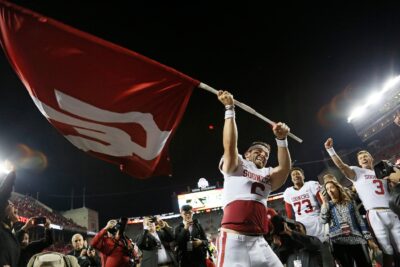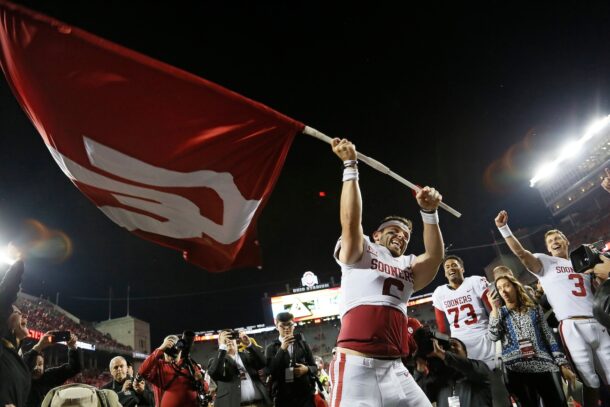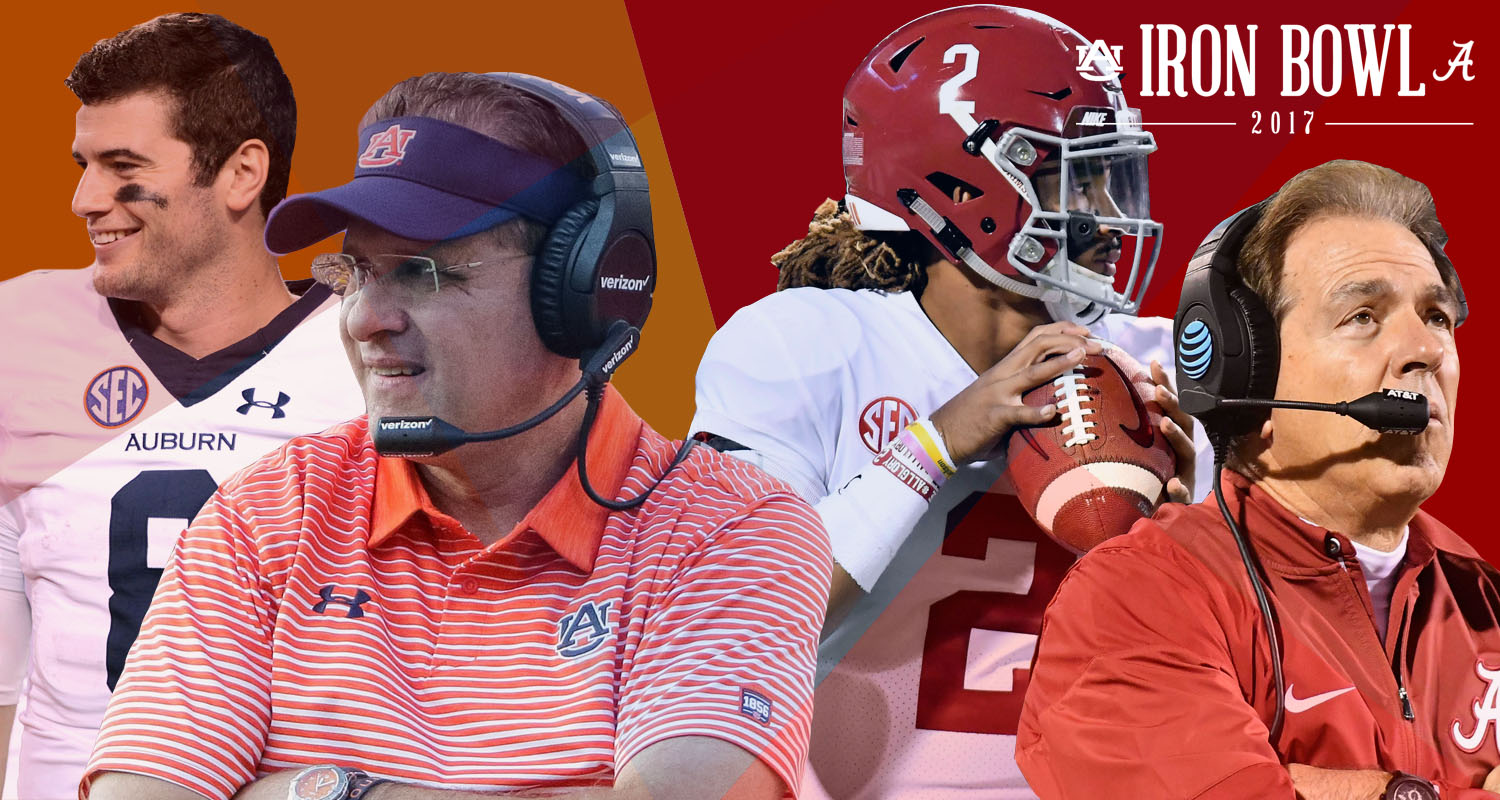
The Ultimate Iron Bowl Preview: As good as college football gets, minus the scoring
By Matt Hinton
Published:
As a spectacle, Saturday’s showdown between Alabama and Auburn is college football at its best: Packed house, long memories, fraternal tensions, maximum stakes. Tradition, and all that. This is one of those years in the life cycle of the sport when the heat on this rivalry, which simmers year-round, 24/7/365, gets cranked up to full blast. Winner takes all — bragging rights, SEC West crown, shot at Georgia with a guaranteed Playoff slot on the line in Atlanta — loser goes home. (Or at least to a bowl game that’s not the Sugar.) Two seasons full of potential and hope and anxiety and momentum arriving at a crescendo in the same and place, where everyone on one side also happens to despise everyone on the other.
The past two times the Iron Bowl felt this big, in 2010 and 2013, the result was a pair of instant classics that ascended immediately into legend. The scene in Jordan-Hare is going to be as good as this sport gets, or any sport.
As a football game, it’s going to be a slugfest. A classic slugfest, if you prefer. A vintage slugfest. A throwback. Choose your adjective — on their biggest stage yet, these are two teams designed and primed essentially to beat the hell out of each other.
Don’t get me wrong: These are also two prolific, explosive offenses with an abundance of talent, speed and depth. Both sides have topped 40 points this season more often than not. But fundamentally both are built around their defenses, which rank among the best in the country in almost every conceivable way, and around their defensive lines, in particular, which have controlled every game they’ve played from start to finish. The offenses are versatile, but run-oriented at heart and more than willing to spend three quarters trading body blows if it means being in position to deliver a knockout in the fourth. The coaches know each other all too well, and they know the other will be reluctant to put his sophomore quarterback in a situation to take risks. Put those things together on a chilly, slightly overcast afternoon and it’s probably not going to be pretty, scoreboard-wise.
It will, however, be loud, and raucous, and in terms of settling the West Division crown, definitive. It may get dramatic; it’s certainly going to be fun. If you’re reading this and need any more than that, you may be in the wrong place.
WHEN AUBURN HAS THE BALL …
First of all, breaking news: Alabama’s defense is Alabama’s defense. The Tide come in ranked No. 1 nationally in almost every category that matters, including scoring defense, total defense, pass efficiency defense, and yards per play allowed. (In fact, in that last case they’re giving up fewer yards per carry and per pass than any other defense in the country, which hardly seems fair even for Bama.) In the categories where they don’t rank No. 1 they’re within spitting distance. The same goes for advanced metrics, too, where the Tide are No. 2 in overall Defensive S&P+, No. 4 against the run, and No. 5 against the pass, joining Auburn’s as the only defenses ranked in the top five by all three measures.
For those of you who prefer less advanced metrics, all of the above amounts to a more basic number: In eight games against Power 5 opponents they’ve allowed a grand total of eight offensive touchdowns. Whatever image the words “Alabama defense” invoke in your mind, so far this unit has fully embodied it.
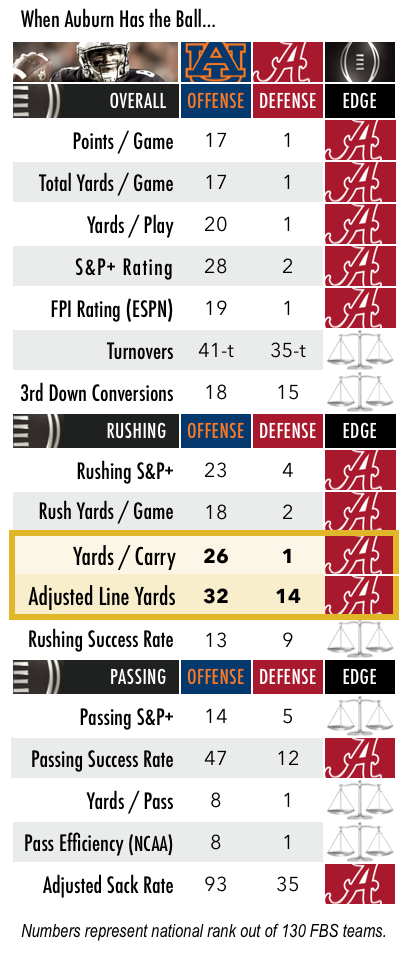 That said. Look closely enough at Bama’s past two SEC games and it’s possible to discern a potential crack or two that wasn’t there over the first two months of the season. LSU ran for 188 yards*, the vast majority of them between the tackles, and generated a handful of golden, game-changing opportunities downfield that only failed because QB Danny Etling’s throws to open receivers were off the mark. Mississippi State didn’t connect on any big plays, but it managed to pound out a living between the tackles, racking up 182 yards rushing*, 22 first downs, and an 18-minute advantage in time of possession. (*All rushing numbers in this post exclude negative yardage on sacks.)
That said. Look closely enough at Bama’s past two SEC games and it’s possible to discern a potential crack or two that wasn’t there over the first two months of the season. LSU ran for 188 yards*, the vast majority of them between the tackles, and generated a handful of golden, game-changing opportunities downfield that only failed because QB Danny Etling’s throws to open receivers were off the mark. Mississippi State didn’t connect on any big plays, but it managed to pound out a living between the tackles, racking up 182 yards rushing*, 22 first downs, and an 18-minute advantage in time of possession. (*All rushing numbers in this post exclude negative yardage on sacks.)
For any other defense, those numbers would be par for the course, or close enough that they were barely worth mentioning. But Alabama has to be judged on a different, much steeper curve: Together, those games marked only the second time in the past seven years the Crimson Tide have allowed 150 rushing yards in back-to-back weeks, with or without sacks; the 2015-16 units that played for the national title only allowed two 150-yard games on the ground, period, over the course of both seasons. And it was largely sustained success; between them, the Tigers and Bulldogs combined for almost as many rushing first downs (18) as Bama’s first six Power 5 opponents combined (19).
In that context, it hardly seems like a coincidence that the decline against the run (again, relatively speaking) has come in the wake of multiple injuries at linebacker, and to starting middle ‘backer Shaun Dion Hamilton, in particular. Hamilton, a senior who was integral in pre-snap communication, left the LSU game early in the third quarter with what turned out to be a season-ending knee injury; shortly after, the Tigers broke their only long run of the night — the longest run Alabama has allowed the past two seasons, in fact — by running directly at his replacement, junior Keith Holcombe (No. 42 in the clip below), out of the Wildcat.
https://www.youtube.com/watch?v=e6siYVPcjT0
Holcombe started the Mississippi State game in Hamilton’s place at MIKE, and was singled out again as one of the main culprits in the Bulldogs’ slow, steady, chain-moving success; he was victimized to some extent on all three of MSU’s touchdowns. Against Mercer, coaches replaced Holcombe with 5-star freshman Dylan Moses, who responded with a spectacular stat line (11 tackles, 4 TFLs, 1 INT) in his first career start. He’ll almost certainly be running with the first unit again Saturday, in vastly more difficult circumstances.
Moses might be on schedule to emerge as the next great Bama linebacker on Nick Saban’s watch, but from the opposite sideline that’s about as encouraging a situation in the middle of the Crimson Tide defense as Auburn could realistically hope for. Since Kerryon Johnson’s return from a hamstring injury, in late September, the Tigers have made a convincing case as one of the most dominant week-in, week-out ground attacks in the country: Against SEC opponents, they’ve averaged 271 rushing yards per game on 5.9 per carry, culminating in their eye-opening, 250-yard romp against Georgia. The Bulldogs went into that game boasting an indomitable defensive front on par with Alabama’s, and limped out of it covered in tread marks.
If there’s a knock on Auburn’s running game, it’s that it’s too dependent on Johnson, who has filled the void left by last year’s star, Kamryn Pettway, by assuming one of the heaviest workloads of any back in the country. (Pettway has missed all or most of eight games with lingering foot and shoulder injuries and is likely done for the season.) At 212 pounds, Johnson is an NFL-ready workhorse in his own right, having logged at least 20 touches in eight straight games, including last week’s tune-up date with UL-Monroe. Sophomore Kam Martin is a competent backup in case of emergency, but there is no rotation here; in a game like the Iron Bowl, the only limits on Johnson’s pitch count will be the down and distance in a given situation and the scoreboard.
The corollary to Johnson’s reliable output on the ground is the steady growth of quarterback Jarrett Stidham, who has turned out to be more or less exactly the guy Auburn fans hoped he would be. That might come as a surprise to the skeptics who wrote him off after the Week 2 debacle at Clemson, but in the meantime Stidham has thrived: In conference games, he leads all SEC starters in completion percentage (65.8), yards per attempt (10.0), touchdown-to-interception ratio (12-1), and overall efficiency (173.7).
In part, that success is due to a screen-heavy philosophy that has minimized the Tigers’ issues in pass protection and yielded consistent returns behind the open-field running of receivers Ryan Davis and Eli Stove, as well as Johnson out of the backfield; between them, Davis, Stove, and Johnson have accounted for at least one big gain in the screen game on a weekly basis, including a pair of touchdowns against Georgia that covered 32 yards (by Davis) and 55 yards (by Johnson), respectively, the latter of which stands as one of the great play calls of the season.
More good stuff by Chip Kelly to detail Kerryon Johnson’s screen pass that led to a touchdown. pic.twitter.com/aqCGM2kodl
— Billy Marshall (@BillyM_91) November 12, 2017
But Stidham’s arm strength is true to the preseason hype: The Tigers’ resident deep threats, Darius Slayton and Will Hastings, have contrasting styles — Slayton uses his 6-2 frame to outmaneuver smaller DBs on contested throws, whereas the diminutive Hastings specializes in double moves from the slot. The results are similar; both average more than 20 yards per catch, with Slayton, in particular, beginning to look like one of the more dangerous long-ball targets in the league. Stidham will be the first opposing passer Alabama has faced this season with legitimate NFL potential, and given enough time in the pocket he’s more than capable of connecting on the kind of downfield opportunities that LSU squandered.
Obviously, that’s a significant caveat: Play-action is integral to Auburn’s passing schemes, and on the rare occasions that the running game has faltered the entire offense has fallen apart. There was, of course, the early collapse at Clemson; Johnson didn’t play that night, and the Tigers’ pass protection has improved significantly since, but the only other opposing defense that has managed to put the offense on Stidham’s shoulders (LSU’s, eventually) is also the only other defense that has succeeded in making him look ordinary. Actually, “ordinary” is being kind — once the running threat was neutralized in Baton Rouge the passing game went off the rails, too, with Stidham finishing 1-for-12 for zero yards on his last dozen attempts.
Is it possible that he’s grown up enough in the ensuing weeks to overcome a similar situation, against an even better defense? Sure: He has all the tools athletically, and his confidence in the wake of the Georgia game, in front of a home crowd, should be sky-high. But presumably that’s a question Auburn would rather not have to answer.
Key Matchup: Auburn OL Casey Dunn vs. Alabama DT Da’Ron Payne
Dunn is the most obscure starter on either side of the ball on either team, and probably the most unlikely: As a graduate transfer from Jacksonville State, he wasn’t heavily recruited, wasn’t on the team in spring practice, and wasn’t listed on any preseason depth chart. He didn’t see the field at all in Auburn’s first two games. Once he was in the lineup, though, Dunn was entrenched, starting seven of the last eight at center and emerging as an anchor of the front five alongside All-SEC guard Braden Smith.

According to Pro Football Focus, Dunn’s individual grade in the win over Georgia was the best on the team, which anyone who watched Kerryon Johnson repeatedly gashing the middle of the UGA defense could have predicted.
I don’t have all the numbers, but it’s a good bet that no opposing lineman has ever graded out well against Payne, a classic two-gap Bama behemoth who routinely absorbs double teams and makes life incalculably easier for whoever has the good fortune to be playing linebacker behind him. This week, that happens to be a true freshman, Dylan Moses, who’s learning on the fly but clearly is capable of taking advantage of an unobstructed path to the ball. Don’t even bother looking up Payne’s name in the box score; if Moses fares even half as well on paper as he did in his debut, that will tell you everything about Payne’s immovable presence inside you need to know.
WHEN ALABAMA HAS THE BALL …
Bama’s offense is a marvel of explosiveness, depth and efficiency, on par statistically with any attack in school history. Yet for all the numbers I could conceivably throw at you, the most impressive is also the smallest: Two. That’s the number of turnovers committed by Alabama’s starting offense so far this season. Two. In more than 500 competitive snaps over the course of 11 games. One fumble. One interception. That’s it.
In fact, both of those giveaways came in the same game, a 41-9 win over Arkansas; in the other 10 the first-string hasn’t committed a turnover at all. The backups have responsible for a couple of lost fumbles in garbage time, as well as an eventful but ultimately meaningless pick-six against Tennessee, and the punt returners have biffed a few fair catches. The starters have offered almost no glimmers of hope whatsoever.
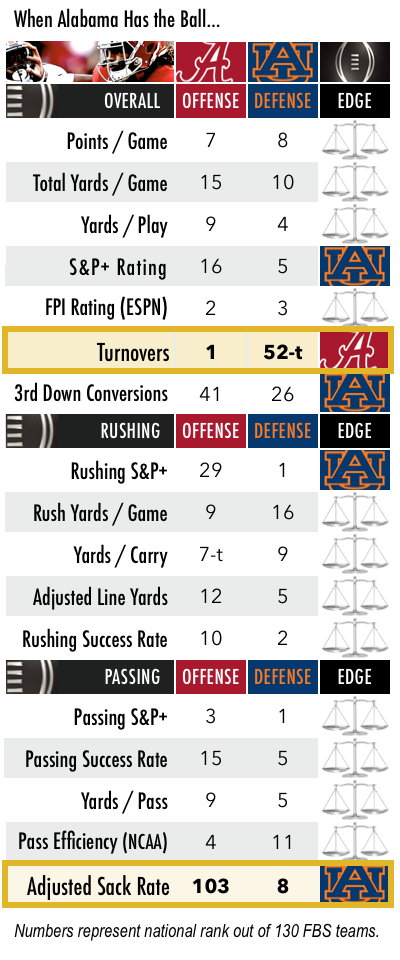 That’s a testament both to the Tide’s overwhelming talent — they’re dominant enough on a regular basis that they rarely have to take chances — and especially to their eternally placid quarterback, sophomore Jalen Hurts, who has seemed almost impervious to big mistakes. As a passer, Hurts has improved his recognition of what defenses are showing him in year two and relied far less on the kind of safe, horizontal throws that served to inflate his passing numbers in 2016. As a runner, Hurts is still logging about 10 carries per game, slightly down from last year, but handling the ball at least twice as often in the option game, where the split-second decision to keep or give typically carries a higher fumble rate at the mesh point; for Hurts it’s virtually automatic.
That’s a testament both to the Tide’s overwhelming talent — they’re dominant enough on a regular basis that they rarely have to take chances — and especially to their eternally placid quarterback, sophomore Jalen Hurts, who has seemed almost impervious to big mistakes. As a passer, Hurts has improved his recognition of what defenses are showing him in year two and relied far less on the kind of safe, horizontal throws that served to inflate his passing numbers in 2016. As a runner, Hurts is still logging about 10 carries per game, slightly down from last year, but handling the ball at least twice as often in the option game, where the split-second decision to keep or give typically carries a higher fumble rate at the mesh point; for Hurts it’s virtually automatic.
As a team, Bama divvies up carries equally between Hurts and the top two tailbacks, Damien Harris and Bo Scarbrough, preventing any of them from racking up the individual numbers and accolades they’d enjoy almost anywhere else. But you don’t have to watch long to realize only one of them is indispensable.
The standing issue with Hurts is the same as it was on Jan. 9: Does he have the arm to challenge a top-shelf defense downfield, in a close game, when the Crimson Tide need points and aren’t running at will? Last year the answer was no; Hurts’ passing production severely declined in the postseason, which in retrospect looked like the most glaring flaw that prevented an otherwise dominant outfit from repeating as national champs. He’s narrowly passed his first two tests this year, against LSU and Mississippi State, mainly by forming a Vulcan mind meld with Calvin Ridley. (Although Ridley didn’t score a touchdown himself in either of those games, all eight of his receptions led directly to points while the rest of the offense sputtered.) Auburn will represent the first real, Playoff-level challenge against a defense ideally suited to reducing a young quarterback to a heap.

Not to suggest that the Tigers are about to stage a reenactment of the beatdown they put on Georgia, which was unlikely enough the first time — it was Auburn’s best defensive performance of the season by a country mile, and adjusted for the competition it has to be on the short list of the best defensive performances by any team. It was not a twice-in-three-weeks kind of effort.
But it did establish Kevin Steele’s unit as an elite one, elevating Auburn to No. 1 nationally in the Defensive S&P+ ratings against both the run and pass. It also established the template the Tigers hope to follow against Hurts: Neutralize the run, force the quarterback out of his comfort zone on obvious passing downs, and keep raising the heat until he buckles beneath the pass rush. The Bulldogs’ precocious freshman QB, Jake Fromm, spent two months building a reputation for poise beyond his years, and without a steady ground game to fall back on watched it unravel in about two hours.
Hurts has been around the block now against some very good, athletic defenses, so unlike Fromm he’s not likely to see anything he hasn’t seen before from the likes of Washington, Clemson, Florida State, Texas A&M, LSU, et al. But those teams all fared relatively well against Alabama’s offense, and in LSU’s case even managed to hold the running game in check to an extent no other defense has managed since Hurts was promoted to QB1.
The biggest issue for the offensive line (just as was for Georgia’s o-line) will be giving Hurts enough time to at least make throwing downfield a viable option. Pass protection has been a persistent problem over the second half of the season — the Crimson Tide have allowed multiple sacks in each of the last five SEC games, including three to Texas A&M, four to LSU, and five to Mississippi State. They rank a dismal 103rd in Adjusted Sack Rate, and 126th when dropping back on standard downs (i.e. run downs). They’ll likely also be missing veteran guard Ross Pierschbacher, a mainstay up front with 40 consecutive starts under his belt prior to an ankle injury against Mississippi State, for the second week in a row.
By contrast, Auburn ranks eight in Adjusted Sack Rate and arguably gets after the quarterback better than it does anything else on either side of the ball. All four d-line starters were credited with a sack against Georgia, at various points victimizing every starter on the Bulldogs’ front five, which pretty well sums up the challenge: The pressure can come from any direction.
Jeff Holland is just a monster.
He comes up with the big play for @AuburnFootball. pic.twitter.com/w5NzNj1v8x— SEConCBS (@SEConCBS) November 11, 2017
Key Matchup: Alabama OL Matt Womack vs. Auburn DE Jeff Holland
The most likely direction is which ever direction Holland is coming from on a given snap. An OLB/Edge type in the Dee Ford mold, Holland is tied for the SEC lead with nine sacks and just one off the national lead with four forced fumbles; he harbors legitimate All-American aspirations as a first-year starter. Georgia tried to block him with a true freshman tackle, Andrew Thomas, which went as poorly as you’d expect — Holland set the tone for the afternoon with a monster sack on UGA’s second offensive series and was also credited with three QB hurries.
No doubt Alabama would prefer to see Holland lined up opposite left tackle Jonah Williams than Womack, a 6-7, 324-pound giant on the right side whose size has served him much better this year as a run blocker than it has against speed rushers. Either way, keeping a running back or H-back in to help out is advisable.
SPECIAL TEAMS AND OTHER VAGARIES
As always, Auburn has at least one distinct advantage in the kicking game thanks to senior Daniel Carlson, whose record-breaking leg extends the Tigers’ potential scoring range by about 10 yards compared to the average college kicker. This season hasn’t been Carlson’s best — he’s missed 6 of his 25 field goal attempts, including two blocks at Texas A&M — but he’s still a finalist for the Lou Groza Award for the third year in a row, and frankly even the misfires reflect Auburn’s confidence in him from long distance: Five of the six misses have come from 46 yards or longer. On the other hand, Carlson’s also made seven field goals from that distance, including a season-long 54-yarder against Georgia. He’s a sure a bet for a long NFL career as anyone on the field.
Alabama … not so much. The Tide’s regular kicker, Alex Pappanastos, has been fine on shorter kicks, hitting all 11 of his attempts from 39 yards in. But from further out it’s been an adventure: Pappanastos is just 4-of-8 from beyond 40 yards, and hasn’t even attempted a kick from 50-plus. Punter JK Scott is the designated long-distance kicker, for whatever the distinction is worth, but he’s missed both of his attempts in the 50-yard range and hasn’t been called on for another since early October.
Scott is the better punter in this game, by far, largely because his boots are almost un-returnable: Opponents have just four returns all year, fewest in the SEC, compared to 21 fair catches, 21 punts that dropped inside the 20-yard line, and just three touchbacks. In a field position game, Scott is a luxury and a weapon. Unfortunately, Alabama’s return units have tended to offset that advantage, uncharacteristically ranking among the worst in the conference on both kickoff and punt returns even before accounting for multiple fumbles on the latter. Aside from a 70-yard kickoff return against Ole Miss by true freshman Noah Igbinoghene, Auburn hasn’t fared much better. A big, momentum-swinging return on Saturday isn’t out of the question, given the athletes involved, but it would be out of the blue.
On the injury front, Alabama’s attrition at linebacker has earned most of the headlines, but the biggest question mark on Saturday is Auburn linebacker Tre’ Williams, a senior starter who aggravated a shoulder injury against UL-Monroe that’s already kept him out of all or most of four games. He’s questionable. Alabama’s health issues are more definitive, with the possible exception of Minkah Fitzpatrick’s wonky hamstring; earlier this week Fitzpatrick claimed he was “100 percent right now” after sitting out last week vs. Mercer, which snapped his streak of 35 consecutive starts but probably doesn’t mean anything for this weekend. Expect him at more or less full speed.
SIX PREDICTIONS
1. Auburn’s pass rush forces a rare turnover by Hurts, leading to points, but struggles to generate sustained pressure.
2. Dylan Moses records at least 10 tackles in his second career start, but none behind the line of scrimmage.
3. Kerryon Johnson sets a career-high for carries, averages less than 4 yards a pop, and narrowly cracks the century mark without a run longer than 15 yards.
4. With all eyes in Auburn’s secondary on Ridley, Alabama gets at least one big play from its freshman WR trio of Jerry Jeudy, DeVonta Smith, and Henry Ruggs III.
5. Alabama trails briefly in the first half but outscores Auburn by double digits in the second, ultimately setting new season highs against the Tigers defense for rushing yards and yards per carry.
6. ALABAMA WINS, 30–19
Matt Hinton, author of 'Monday Down South' and our resident QB guru, has previously written for Dr. Saturday, CBS and Grantland.


